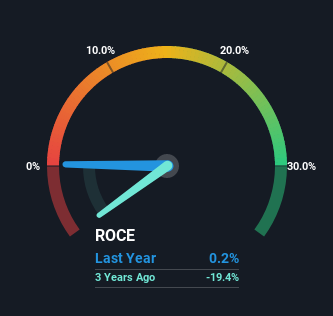- Australia
- /
- Hospitality
- /
- ASX:RFG
Here's What's Concerning About Retail Food Group's (ASX:RFG) Returns On Capital
When it comes to investing, there are some useful financial metrics that can warn us when a business is potentially in trouble. More often than not, we'll see a declining return on capital employed (ROCE) and a declining amount of capital employed. This combination can tell you that not only is the company investing less, it's earning less on what it does invest. So after we looked into Retail Food Group (ASX:RFG), the trends above didn't look too great.
What Is Return On Capital Employed (ROCE)?
Just to clarify if you're unsure, ROCE is a metric for evaluating how much pre-tax income (in percentage terms) a company earns on the capital invested in its business. Analysts use this formula to calculate it for Retail Food Group:
Return on Capital Employed = Earnings Before Interest and Tax (EBIT) ÷ (Total Assets - Current Liabilities)
0.0016 = AU$407k ÷ (AU$356m - AU$96m) (Based on the trailing twelve months to December 2022).
So, Retail Food Group has an ROCE of 0.2%. Ultimately, that's a low return and it under-performs the Hospitality industry average of 8.1%.
See our latest analysis for Retail Food Group

Above you can see how the current ROCE for Retail Food Group compares to its prior returns on capital, but there's only so much you can tell from the past. If you're interested, you can view the analysts predictions in our free report on analyst forecasts for the company.
SWOT Analysis for Retail Food Group
- Debt is well covered by cash flow.
- Interest payments on debt are not well covered.
- Shareholders have been diluted in the past year.
- Expected to breakeven next year.
- Has sufficient cash runway for more than 3 years based on current free cash flows.
- Trading below our estimate of fair value by more than 20%.
- No apparent threats visible for RFG.
What Does the ROCE Trend For Retail Food Group Tell Us?
In terms of Retail Food Group's historical ROCE trend, it isn't fantastic. To be more specific, today's ROCE was 4.4% five years ago but has since fallen to 0.2%. In addition to that, Retail Food Group is now employing 66% less capital than it was five years ago. The combination of lower ROCE and less capital employed can indicate that a business is likely to be facing some competitive headwinds or seeing an erosion to its moat. Typically businesses that exhibit these characteristics aren't the ones that tend to multiply over the long term, because statistically speaking, they've already gone through the growth phase of their life cycle.
On a side note, Retail Food Group's current liabilities have increased over the last five years to 27% of total assets, effectively distorting the ROCE to some degree. Without this increase, it's likely that ROCE would be even lower than 0.2%. While the ratio isn't currently too high, it's worth keeping an eye on this because if it gets particularly high, the business could then face some new elements of risk.
What We Can Learn From Retail Food Group's ROCE
To see Retail Food Group reducing the capital employed in the business in tandem with diminishing returns, is concerning. Unsurprisingly then, the stock has dived 91% over the last five years, so investors are recognizing these changes and don't like the company's prospects. With underlying trends that aren't great in these areas, we'd consider looking elsewhere.
If you'd like to know about the risks facing Retail Food Group, we've discovered 2 warning signs that you should be aware of.
For those who like to invest in solid companies, check out this free list of companies with solid balance sheets and high returns on equity.
New: AI Stock Screener & Alerts
Our new AI Stock Screener scans the market every day to uncover opportunities.
• Dividend Powerhouses (3%+ Yield)
• Undervalued Small Caps with Insider Buying
• High growth Tech and AI Companies
Or build your own from over 50 metrics.
Have feedback on this article? Concerned about the content? Get in touch with us directly. Alternatively, email editorial-team (at) simplywallst.com.
This article by Simply Wall St is general in nature. We provide commentary based on historical data and analyst forecasts only using an unbiased methodology and our articles are not intended to be financial advice. It does not constitute a recommendation to buy or sell any stock, and does not take account of your objectives, or your financial situation. We aim to bring you long-term focused analysis driven by fundamental data. Note that our analysis may not factor in the latest price-sensitive company announcements or qualitative material. Simply Wall St has no position in any stocks mentioned.
About ASX:RFG
Retail Food Group
A food and beverage company, engages in the management of a multi-brand retail food and beverage franchise in Australia and internationally.
Good value with adequate balance sheet.
Market Insights
Community Narratives





